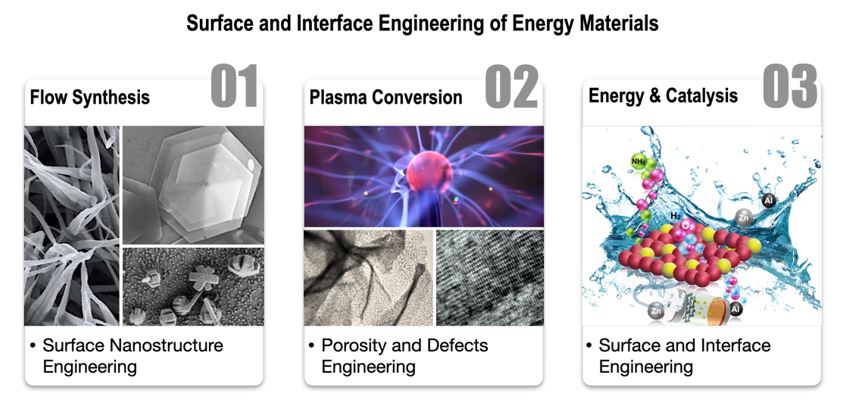Video Article Open Access
Surface and Interface Engineering of Energy Materials
Weijie Zhu1, Fangwang Ming2, Jiaxian Zheng1, Hanfeng Liang1,3,
1State Key Laboratory of Physical Chemistry of Solid Surfaces, College of Chemistry and Chemical Engineering, Xiamen University, Xiamen, 361005, China
2Materials Science and Engineering, King Abdullah University of Science and Technology, Thuwal, 23955, Saudi Arabia
3Innovation Laboratory for Sciences and Technologies of Energy Materials of Fujian Province (IKKEM), Xiamen 361005, China
Vid. Proc. Adv. Mater., Volume 3, Article ID 2210349 (2022)
DOI: 10.5185/vpoam.2022.10349
Publication Date (Web): 16 Oct 2023
Copyright © IAAM
Graphical Abstract

Abstract
Energy and environment are the two main challenges facing our society. Practical large-scale utilization of renewable energy (such as solar and wind) requires both efficient energy conversion and energy storage. Since most of the energy conversion and storage processes involves the surface reactions and electrode-electrolyte interfaces, the regulation of the surface and interface property of nanomaterials therefore serves as a power tool for enhancing their overall performance. We developed novel synthetic approaches (i.e., continuous flow synthesis and plasma conversion synthesis) to manipulate the surface morphology, nanoscale porosity, and atomic defects of nanomaterials and explored their applications in electrocatalytic oxygen evolution, hydrogen evolution, nitrate reduction, and aqueous rechargeable batteries, and further demonstrated the structure-property-device performance relationship. We also developed new devices by coupling different catalytic reactions to enable the simultaneous fuel production and electricity generation upon wastewater purification.
Keywords
Surface; interface; screw dislocation; plasma; energy storage and conversion.
Acknowledgement
The authors thanks the support from National Natural Science Foundation of China (Grant No.: 22001081), the Science and Technology Projects of Innovation Laboratory for Sciences and Technologies of Energy Materials of Fujian Province (IKKEM, Grant No.: HRTP-[2022]-7) and the Fundamental Research Funds for the Central Universities, China (Grant No.: 20720210010),
References
- Y. Zeng, M. Zhao, Z. Huang, W. Zhu, J. Zheng, Q. Jiang, Z. Wang, H. Liang, Advanced Energy Materials, 2022, 12, 2201713.
- W. Zhu, A. N. Gandi, Q. Wu, H. Yan, M. Zhao, Z. Wang, H. Liang, Chemical Engineering Science, 2022, 258, 117769.
- J. Zheng, Z. Huang, Y. Zeng, W. Liu, B. Wei, Z. Qi, Z. Wang, C. Xia, H. Liang, Nano Letters, 2022, 22, 1017-1023.
- J. Zheng, Z. Huang, F. Ming, Y. Zeng, B. Wei, Q. Jiang, Z. Qi, Z. Wang, H. Liang, Small, 2022, 18, 220006.
- H. Liang, Z. Cao, C. Xia, F. Ming, W. Zhang, A. H. Emwas, L. Cavallo. H. N. Alshareef, CCS Chemistry, 2021, 3, 1553-1561.
Biography
Hanfeng Liang is an associate professor at Xiamen University. Before joining Xiamen University, he was a visiting scholar at University of Wisconsin-Madison and a postdoc at King Abdullah University of Science and Technology. He currently serves as a Section Associate Editor for Frontiers in Materials and is on the Wiley’s Chemistry and Chemical Engineering Advisory Panel and the (youth) editorial board of several journals (e.g., The Innovation, Exploration, Chinese Chemical Letter, Catalysis Communications). He was named in the World’s top 2% Scientist List for 2 consecutive years (2019 & 2020). His research interest lies on rational synthesis of nanomaterials and functional coatings for electrocatalysis and energy storage. Dr. Liang has published over 70 paper with > 8000 citations (h-index 39).
Video Proceedings of Advanced Materials

Upcoming Congress



